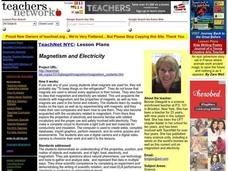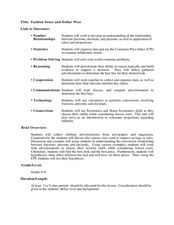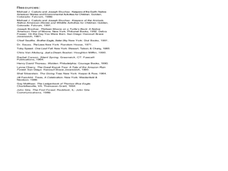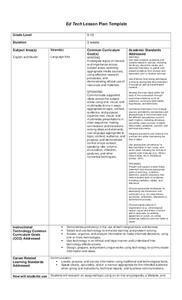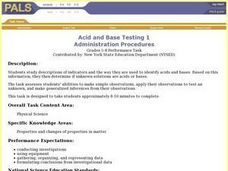Curated OER
Acids and Bases: Their Reactions, Conductivity, Base Indicators and Neutralization Reaction
Students conduct experiments and collect data to determine physical and chemical characteristics of acids and bases.
Curated OER
What's The Matter: A Sinker or Floater?
Students conduct an experiment. For this water lesson, students watch the lesson "Float and Sink" on an interactive website. Students learn how to test items in water and then work in groups to test their items. Students discuss their...
Curated OER
Types of Marine Debris
Students conduct an experiment. In this marine debris and environment protection lesson, students categorize trash into piles, predict whether these trash items will sink, float or be picked up and carried by the wind and then test...
Curated OER
Magnetism and Electricity
Students demonstrate a comprehension of the properties, position, and motion of objects and materials, and of light, heat, electricity, and magnetism. They use materials to assemble an electric circuit and test materials, including...
Curated OER
Fashion Sense and Dollar Wise
Students work in groups to show understanding of the relationship between fractions, decimals, percentages, and the application of ratios and proportions. In this decimals, fractions, and percents lesson, students use real life consumer...
Curated OER
Ready, Set, Go!
Middle schoolers predict if the height of a ramp affect how far an object travels. They design and conduct an experiment to test their predictions. The results are recorded and a graph is created to show the relationship between ramp...
Curated OER
Red Tail Ridge Wetland Study Project
Fifth graders use a real life scenario of the wetlands to gather information on creatures of the habitat. In this wetlands lesson, 5th graders research the interdependence of organisms in a healthy habitat. Students collected...
Curated OER
Frozen, Canned or Fresh?
Young scholars compare spinach. In this Science lesson, students construct an experiment to test fresh, frozen, and canned spinach taste and texture. Young scholars record their findings in charts and graphs.
Curated OER
Dirty Decomposers
Learners explore the ecosystem by conducting a ziploc bag experiment. In this recycling lesson, students identify decomposer organisms in our environment and how they speed up the recycling process. Learners utilize a ziploc plastic bag,...
Curated OER
Time is On My Side!
Fourth graders review the most effective test taking and studying skills. As a class, they are introduced to how to self-manage themselves when it comes to the activities they have to complete. To end the lesson, they complete a pretend...
Curated OER
Ed Tech
Students access and evaluate authority of electronic resources. They synthesize data from multiple sources. Students compose a Works Consulted page. They prepare and deliver an informative speech on a disease or medical condition.
Discovery Education
Cool It!
Adjust the melting time of ice without varying the temperature! Learners experiment with different materials to decide how the materials affect the rate an ice cube melts. They then connect their findings to the conductivity of each...
Curated OER
Learning Vocabulary by Using Reference Materials
Finding engaging ways to help your middle schoolers build their vocabulary is not easy to do. The lesson presented here offers a great way to motivate them to build vocabulary by making it into a game. Teams of pupils use a dictionary...
Curated OER
Design Team Challenge
Students work in groups to build a robot. In this robotics lesson, students create an electronic robot and program it to follow directions. They create an obstacle course for the robot to follow and test its performance.
Curated OER
How Effective is Perspiration at Cooling?
Students collect data on the cooling of water in two different test tubes, one that is wrapped in wet newspaper and one in dry newspaper. They then relate this cooling effect to the body's perspiration.
Curated OER
Open-Ended Scientific Method Lab
Students inspect a given problem and come up with a hypothesis. In this investigative lesson students come up with a hypothesis for a problem, test each hypothesis and evaluate how successful each one was.
Curated OER
Unfold the Mystery of Mold
Young scholars research the conditions in which molds thrive. They apply the scientific method to develop a hypothesis, conduct research and test results.
Curated OER
Make A Plan
In this science worksheet, learners create a plan on what product they will test. They describe what they want to discover about this product and write questions that address the goal of their experiment. Finally, students determine what...
Curated OER
Science: Entomology in Action
Young scholars discover how coroners use insect life cycles to estimate the time of death in cases. they describe how forensic entomologists combine environmental factors with insect life cycles to note the changes. Students examine an...
Curated OER
Creating an Experimental Design
Students research the damage to the environment by certain plant species. They create an experimental design which they test how these species take over certain habitats. They share their information with the class.
Curated OER
Language Arts: The Doctor Will See You Now
Students are able to compare the treatments available for certain medical conditions during three different points in time during the last hundred years; list the medicines and drug therapies available now that have helped them and those...
Curated OER
Weather and Oceans: Uneven Heating of the Earth
Students investigate what causes the heat on Earth. In this Earth heating lesson, students experiment with different heat sources and determine where the Earth gathers the most heat. Students explore vocabulary words...
Curated OER
Testing the Hypothesis
Students create and conduct various experiments to determine the origin of a family artifact, and then determine whether their results were successful. Students summarize their results and evaluate whether their hypotheses were correct.
Curated OER
Acid and Base Testing
Students study descriptions of indicators and the way they are used to identify acids and bases. They use this information to determine if unknown solutions are acids or bases.



